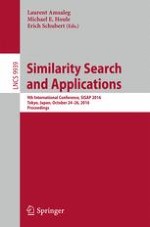2016 | Buch
Similarity Search and Applications
9th International Conference, SISAP 2016, Tokyo, Japan, October 24-26, 2016, Proceedings
herausgegeben von: Laurent Amsaleg, Michael E. Houle, Erich Schubert
Verlag: Springer International Publishing
Buchreihe : Lecture Notes in Computer Science
